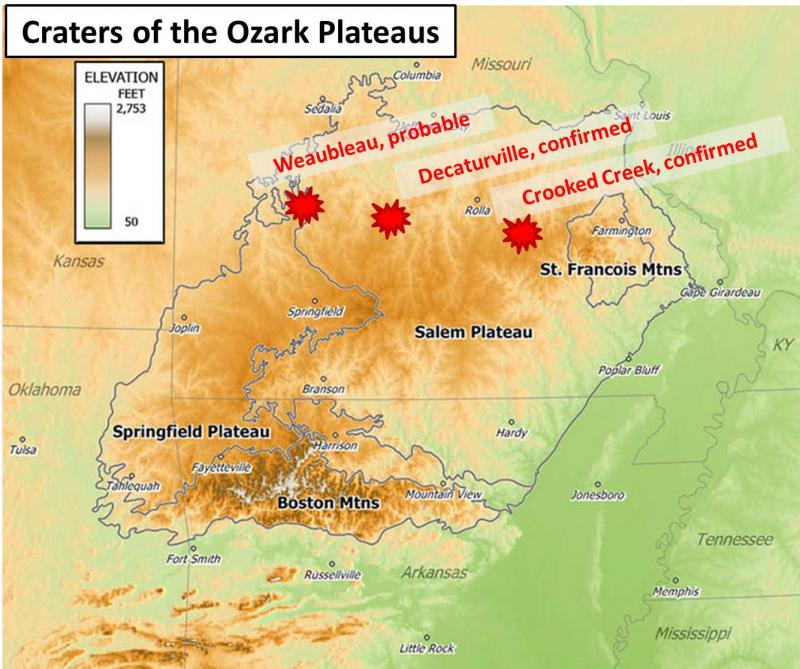This impact occurred between the latest Osagean to earliest Meramecian stage of the Mississippian era.
That’s about 340 million years ago.

Facts about the Weaubleau structure
- Is the largest exposed untectonized meteor impact crater in the US
- It is the fourth largest in the US
- The structure is about 19 km (or about 11-12 miles) wide
- And is remarkably well preserved. The reason it is well preserved is because when this impact occurred there was 50 foot of ocean on top of the area.
- Because the site was covered by later Pennsylvanian Period sediments, and only partially exposed to erosion relatively recently, its structure is well preserved, and its age can be determined with fair accuracy. It is one of a series of known or suspected impact sites along the 38th parallel in the states of Illinois, Missouri, and Kansas. These 38th parallel structures are thought to possibly be the result of a serial impact, and if it can be proven it will be the first time in history that such an event would have happened on earth.
Some of the qualifications for "crater" status are
- breccia – “rocks all crumbed up, with no obvious signs of sedimentary lines. ”
- Inverted strata “Rock that we know is 50 million years old that is on top of rock that we know is only 10 million years old”
- Geomagnetic – mascons "found by using satellites, it is differences in the magnetic field of the earth"
- Topology – "elevation changes"
- Shocked quarts "like mini fault lines in quarts"
- Shattercones [This is still not yet found] "basically it is like a web of cracks that go deep into the rock as a result of the impact"
Normal sediment

breccia

Inverted strata

Mascons

shocked quarts

shattercones

So what is so unique here besides the usual structure or crater geology?
Nearly perfect round rocks that have been called many names. These “egg” looking rocks range in size and roundness but all of them have a shale core that is green and the rock themselves is very light. The current theory is that when this impact occurred bits of the shale in the bedrock was thrown up into the atmosphere and then rained back down into the ocean and secretions formed around the shale rock. And if you find these round types of rocks you are within 10 miles of Osceola Missouri. It is the only place in the world that these types of rocks are found.

So where is this area?
along the 38th parallel




Photo credit Dr. Kevin R. Evans Assistant Professor of Geology at MSU
You can clearly see the "smaller" circle which is within the larger one known as the Weaubleau structure.
**Logging requirements**
DO NOT POST ANSWERS IN YOUR LOG.
Send the following answers to me via email.
- The text "GC55QYK Oh gee... ode" on the first line
- At the posted coordinates, how many years did the water not have a major impact on eroding this impact crater, because of the dam?
- At waypoint "Rock Observations North" Look around, did you find any rounded egg like rocks? Missouri Department of Conservation will give you a ticket if you are caught taking these rocks, so don’t take any!
- Do you see any normal lines of sediment like the photo above or is it a clear example of breccia
- Between waypoint "half #1" and "half #2" what has been made out of the round rocks?
- What size's do you see that were used to build these structures?
- At waypoint "Rock Observations", do you see any normal lines of sediment like in the photo above or is it a clear example of breccia ?
| I have earned GSA's highest level: |
 |
Resources and credits
- Beveridge, T.A., 1949, The geology of the Weaubleau quadrangle, Missouri: State University of Iowa, unpublished doctoral dissertation, Iowa City, Iowa, 199 pp.
- BEVERIDGE, T.R., 1951, The geology of the Weaubleau Creek Area, Missouri: Missouri Geological Survey and Water Resources Report, Second Series, v. 32, 111 pp.
- DULIN, S.A., GARDNER, K.G., ELMORE, R.D., TOTTEN, L.A., EVANS, K.R., MILLER, J.F., AND ROVEY, C.W., II, 2004, Paleomagnetism of the Weaubleau-Osceola impact structure, SW Missouri: Eos Eos Transactions, American Geophysical Union, 85(17), Joint Assembly Supplement, Abstract GP31A-07.
- Dulin, S.A., Gardner, K.G., Elmore, R.D., and Totten, L.A., 2004, Post-Deformational Remagnetization of the Weaubleau-Osceola Structure, SW Missouri (abstract). Geological Society of America 2004 Annual Meeting Abstracts with Program, v. 36(5), p. 145. http://gsa.confex.com/gsa/2004AM/finalprogram/abstract_77508.htm
- Dulin, S. and Elmore, R. D., 2008, Paleomagnetism of the Weaubleau-Osceola structure, southwestern Missouri, in Evans, K. R. Horton, J. W. Jr., King, D. T., Jr., and Morrow, J. R., eds., The Sedimentary Record of Meteorite Impacts: Geological Society of America Special Paper 437, 55-64.
- 2003 LPSC abstract Evans et al., http://www.lpi.usra.edu/meetings/largeimpacts2003/pdf/4111.pdf
- Evans, K.R., 2003, Missouri State Geologists Investigate Large Meteorite Impact Site in Southwestern Missouri: Missouri State Geoscience Fact Sheet, no. 1, 4 pp.
- Evans, K.R., Mickus, K.L., Rovey, C.W. II, Davis, G.H., 2003, The Weaubleau Structure: Evidence of a Mississippian Meteorite Impact in Southwestern Missouri. Association of Missouri Geologists Field Trip Guidebook, 50th Annual Meeting. Missouri Department of Natural Resources., p. 1-30
- http://courses.missouristate.edu/KevinEvans/publinks.htm
- http://courses.missouristate.edu/KevinEvans/impacts.htm
- http://en.wikipedia.org/wiki/Weaubleau_structure